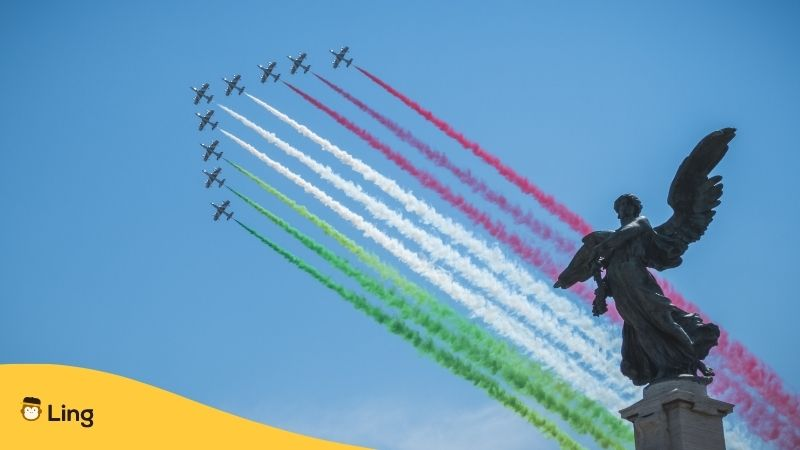The Italian national flag, “Il Tricolore,” is an iconic emblem of Italian culture that is as Italian as Gucci handbags, ice cream, and flamboyant political leaders. Consisting of three vertical bands of green, white, and red, the Italian tricolor represents the unity, heritage, and pride of the Italian nation.
Beyond its visually unmistakable design, the flag serves as a powerful symbol that reflects the rich history, diverse culture, and unwavering spirit of the Italian people. So, let’s explore the history of the Italian flag, delve into its symbolic meaning, and highlight its importance in Italy’s past, present, and future.
Italian Flag History And Evolution
The origins of the Italian flag can be traced back to the late 18th century during the period of the Italian Risorgimento, a movement for the unification of Italy. Inspired by the ideals of the French Revolution, the Italian tricolor flag was adopted as a symbol of independence and national identity by the Italian troops as new political and military groups were focusing on creating unity. The flag’s design drew inspiration from the French flag, which featured three vertical bands of blue, white, and red.
The first official use of Italian flags took place in 1797 in the city of Reggio Emilia, where it was hoisted during a popular uprising against foreign rule. Over time, the flag gained prominence and became a powerful symbol of unity and resistance against foreign domination. Inspired by the Napoleonic military flags, the tricolor had a fancy golden Napoleonic eagle as a central emblem, while the Emperor was in power until 1814.
During the struggle for Italian unification, several variations of the official flag were used by different factions and regions. However, it wasn’t until 1946, following the end of World War II in Western Europe and the fall of the fascist regime, that the current design of the flag was officially adopted. The specific shades of green, white, and red were standardized, and the flag became a cherished symbol of the newly formed Italian Republic.
Symbolic Meaning
Each color of the Italian flag carries its symbolic meaning, representing essential aspects of Italian history, geography, and values.
Green:
The green band on the national banner signifies hope, renewal, and the Italian countryside. The green represents the lush landscapes, fertile fields, and natural beauty found throughout the Italian peninsula. It is also associated with the resilience and vitality of the Italian people.
White:
The central white band symbolizes peace, honesty, and unity. It represents the aspiration for harmony among the diverse regions and cultures that make up Italy. White also signifies the values of equality, justice, and the pursuit of truth, and it represents the snow-covered Alps.
Red:
The red band represents courage, strength, and patriotism. It is a symbol of the blood shed by those who fought for Italy’s independence and the sacrifices made in the struggle for freedom. Red is also associated with love, passion, and the intense spirit of the Italian people.
The tricolor flag is not only a national symbol but also a unifying force that transcends regional differences and reminds Italians of their shared identity and common goals. It serves as a reminder of the struggles and triumphs of the past and instills a sense of pride and belonging among Italians both at home and abroad.

Significance And Cultural Impact
The Italian flag holds immense significance in various aspects of Italian society, culture, and sports.
In politics, the flag is proudly displayed during national holidays, political events, and official ceremonies. It serves as a unifying symbol that represents the values and aspirations of the Italian people, fostering a sense of national pride and identity.
In sports, the tricolor flag is a ubiquitous sight during international competitions, including the Olympics, FIFA World Cup, and Formula One races. It serves as a rallying symbol for Italian athletes and fans, evoking a sense of camaraderie and national unity.
Moreover, the flag is deeply embedded in Italian art, literature, and popular culture. It has inspired countless paintings, sculptures, and creative works that celebrate the nation’s heritage and identity. Additionally, the flag’s iconic colors are often seen in fashion, design, and branding, representing the distinctive Italian style and aesthetic.
Italian Colors For Describing Flags
| English | Italian | Sound |
| White | Bianco | |
| Black | Nero | |
| Blue | Blu | |
| Green | Verde | |
| Red | Rosso | |
| Light blue | Azzurro | |
| Yellow | Giallo | |
| Orange | Arancione | |
| Violet | Viola | |
| Indigo | Indaco | |
| Brown | Marrone | |
| Pink | Rosa | |
| Grey | Grigio | |
| Silver | Argento | |
| Gold | Oro |

The Italian flag, with its iconic tricolor design, represents the unity, heritage, and pride of the Italian nation. Through its historical significance, symbolic meaning, and cultural impact, the flag embodies the spirit of Italy and serves as a powerful reminder of the country’s rich history and diverse culture. It stands as a unifying symbol that transcends regional differences, fostering a sense of national identity and pride among Italians worldwide.
Whether seen fluttering in the wind or proudly displayed during national events, the Italian flag represents the enduring spirit and unwavering resolve of the Italian people. It reminds us of the power of unity and the importance of preserving and cherishing our shared heritage. Just don’t mistake it for the Mexican flag!
Learn More Italian With Ling App
If you are planning a trip to Italy, don’t forget to pack your Ling app. Learning Italian with Ling app is easy, with loads of useful words and phrases at your fingertips. As well as Italian, Ling offers more than 60 other languages, with lessons set by native speakers and lots of fun games and quizzes to keep things casual. Check out Ling app today at Google Play or the App Store.































































